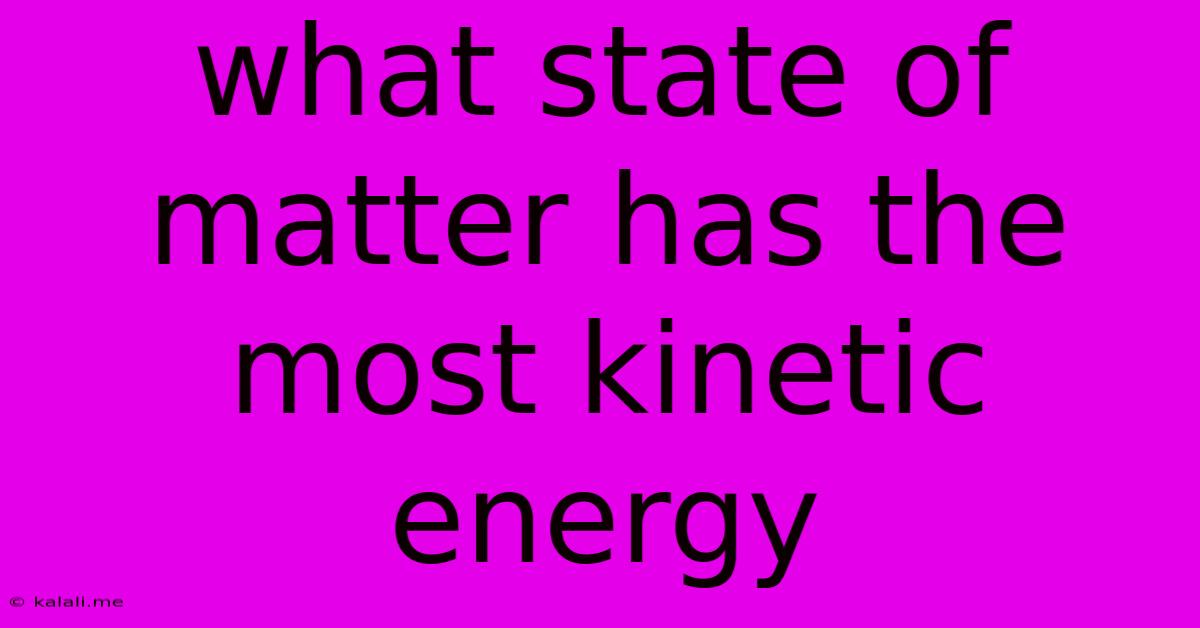What State Of Matter Has The Most Kinetic Energy
Kalali
Jun 14, 2025 · 3 min read

Table of Contents
What State of Matter Has the Most Kinetic Energy?
Meta Description: Discover which state of matter boasts the highest kinetic energy – the answer might surprise you! This article explores the relationship between kinetic energy, temperature, and the states of matter: solid, liquid, gas, and plasma.
Understanding the relationship between kinetic energy and the different states of matter – solid, liquid, gas, and plasma – is crucial in many scientific fields. Kinetic energy, simply put, is the energy of motion. The faster the particles within a substance are moving, the higher their kinetic energy. So, which state of matter exhibits the most vigorous particle movement and, consequently, the highest kinetic energy? The answer isn't as straightforward as you might think.
Understanding Kinetic Energy and States of Matter
The state of matter a substance exists in is directly linked to the kinetic energy of its constituent particles (atoms, molecules, or ions).
-
Solids: In solids, particles are tightly packed together, exhibiting minimal movement beyond minor vibrations around fixed points. Their kinetic energy is relatively low.
-
Liquids: Liquids have a higher kinetic energy than solids. Particles in liquids are more loosely arranged and can move around each other, though they are still relatively close together. This allows for fluidity and the ability to take the shape of their container.
-
Gases: Gases possess significantly higher kinetic energy than solids and liquids. The particles in a gas are far apart and move freely and randomly, colliding frequently with each other and the walls of their container. This random motion is what defines the pressure exerted by a gas.
-
Plasma: Plasma, often called the fourth state of matter, has the highest kinetic energy. In plasma, the electrons are stripped from their atoms, creating a highly energetic state with charged particles moving at incredibly high speeds. This state is often found in stars, lightning, and certain types of flames.
Temperature's Role
Temperature is a direct measure of the average kinetic energy of the particles in a substance. A higher temperature indicates a higher average kinetic energy. Therefore, a substance at a higher temperature will always have a higher average kinetic energy regardless of its state of matter. However, for the same temperature, plasma will always have higher kinetic energy than gases, gases than liquids, and liquids than solids.
The Exception: Temperature Dependence
While plasma generally has the highest kinetic energy, it's important to note the role of temperature. A very cold plasma might have a lower kinetic energy than a very hot gas. The key takeaway is that at a given temperature, the kinetic energy follows this order: plasma > gas > liquid > solid. However, temperature significantly influences the overall kinetic energy of any state of matter. Consider the kinetic energy of the particles in a molten iron versus a cold gas – the molten iron might have a higher average kinetic energy.
Conclusion
While plasma generally holds the title for having the highest kinetic energy, temperature plays a crucial role. At equal temperatures, the order is always plasma, gas, liquid, solid. The key to understanding this lies in the freedom of movement and the energy level of the particles within each state of matter. This fundamental concept has significant implications across various scientific disciplines, from chemistry and physics to materials science and astrophysics.
Latest Posts
Latest Posts
-
Conductor Atoms Normally Have Answer Valence Electrons
Jun 15, 2025
-
Levels Of Processing Model Psychology Definition
Jun 15, 2025
-
How Many District In Up India
Jun 15, 2025
-
A Monopolist Maximizes Profit By Producing The Quantity At Which
Jun 15, 2025
-
Which Is The Densest Planet In The Solar System
Jun 15, 2025
Related Post
Thank you for visiting our website which covers about What State Of Matter Has The Most Kinetic Energy . We hope the information provided has been useful to you. Feel free to contact us if you have any questions or need further assistance. See you next time and don't miss to bookmark.